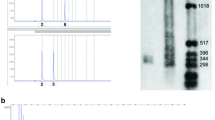Abstract
The expansion in the C9orf72 gene has been recently reported as a genetic cause of Huntington’s disease (HD) phenocopies. We aim to assess the frequency of the C9orf72 gene expansion in a Portuguese HD phenocopies cohort. Twenty HD phenotype-like patients without diagnosis were identified in our institutional database. C9orf72 gene expansion was detected using repeat-primed PCR. Clinical files were reviewed to characterize the phenotype of expansion-positive cases. One patient (5%) was positive for the C9orf72 expansion. A second patient presented 27 repeats—within the intermediate size interval. Both had familial neuropsychiatric disease characterized by diverse movement disorders, dementia, and psychiatric dysfunction that was distinct in severity and clinical expression. C9orf72 disease is clinically heterogeneous and without evident imaging markers. The definition of the role of intermediate alleles and of the pathological threshold for C9orf72 repeat expansions may have diagnostic implications.


Similar content being viewed by others
References
Evans SJ, Douglas I, Rawlins MD et al (2013) Prevalence of adult Huntington’s disease in the UK based on diagnoses recorded in general practice records. J Neurol Neurosurg Psychiatry 84(10):1156–1160. https://doi.org/10.1136/jnnp-2012-304636
Kremer B, Goldberg P, Andrew SE, Theilmann J, Telenius H, Zeisler J, Squitieri F, Lin B, Bassett A, Almqvist E, Bird TD, Hayden MR (1994) A worldwide study of the Huntington’s disease mutation. The sensitivity and specificity of measuring CAG repeats. N Engl J Med 330(20):1401–1406. https://doi.org/10.1056/NEJM199405193302001
Andrew SE, Goldberg YP, Kremer B, Squitieri F, Theilmann J, Zeisler J, Telenius H, Adam S, Almquist E, Anvret M (1994) Huntington disease without CAG expansion: phenocopies or errors in assignment? Am J Hum Genet 54(5):852–863
Wild EJ, Tabrizi SJ (2007) Huntington’s disease phenocopy syndromes. Curr Opin Neurol 20(6):681–687. https://doi.org/10.1097/WCO.0b013e3282f12074
Gövert F, Schneider SA (2013) Huntington’s disease and Huntington’s disease-like syndromes: an overview. Curr Opin Neurol 26(4):420–427. https://doi.org/10.1097/WCO.0b013e3283632d90
Malek N, Newman EJ (2016) Hereditary chorea—what else to consider when the Huntington’s disease genetics test is negative? Acta Neurol Scand 135(1):25–33. https://doi.org/10.1111/ane.12609
Walker RH (2016) The non–Huntington disease choreas five new things. Neurol Clin Pract 6(2):150–156. https://doi.org/10.1212/CPJ.0000000000000236
Hensman Moss DJ, Poulter M, Beck J, Hehir J, Polke JM, Campbell T, Adamson G, Mudanohwo E, McColgan P, Haworth A, Wild EJ, Sweeney MG, Houlden H, Mead S, Tabrizi SJ (2014) C9orf72 expansions are the most common genetic cause of Huntington disease phenocopies. Neurology 82(4):292–299. https://doi.org/10.1212/WNL.0000000000000061
Kostić VS, Dobričić V, Stanković I, Ralić V, Stefanova E (2014) C9orf72 expansion as a possible genetic cause of Huntington disease phenocopy syndrome. J Neurol 261(10):1917–1921. https://doi.org/10.1007/s00415-014-7430-8
Koutsis G, Karadima G, Kartanou C, Kladi A, Panas M (2015) C9ORF72 hexanucleotide repeat expansions are a frequent cause of Huntington disease phenocopies in the Greek population. Neurobiol Aging 36(1):547.e13–547.e16. https://doi.org/10.1016/j.neurobiolaging.2014.08.020
Schottlaender LV, Polke JM, Ling H et al (2015) Analysis of C9orf72 repeat expansions in a large series of clinically and pathologically diagnosed cases with atypical parkinsonism. Neurobiol Aging 36:1221.e1-6. https://doi.org/10.1016/j.neurobiolaging.2014.08.024
(2017) Oral sessions. Eur J Neurol 24:19–122. https://doi.org/10.1111/ene.13366
Acknowledgments
The authors would like to acknowledge the patients and their family for the participation in this study.
Author information
Authors and Affiliations
Corresponding author
Ethics declarations
Informed consent was obtained from all individual participants included in the study. Additional informed consent was obtained from all individual participants for whom identifying information is included in this article.
Conflict of interest
The authors declare that they have no conflict of interest.
Electronic supplementary material
Rights and permissions
About this article
Cite this article
Martins, J., Damásio, J., Mendes, A. et al. Clinical spectrum of C9orf72 expansion in a cohort of Huntington’s disease phenocopies. Neurol Sci 39, 741–744 (2018). https://doi.org/10.1007/s10072-018-3268-7
Received:
Accepted:
Published:
Issue Date:
DOI: https://doi.org/10.1007/s10072-018-3268-7




